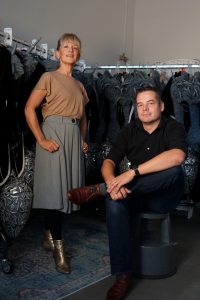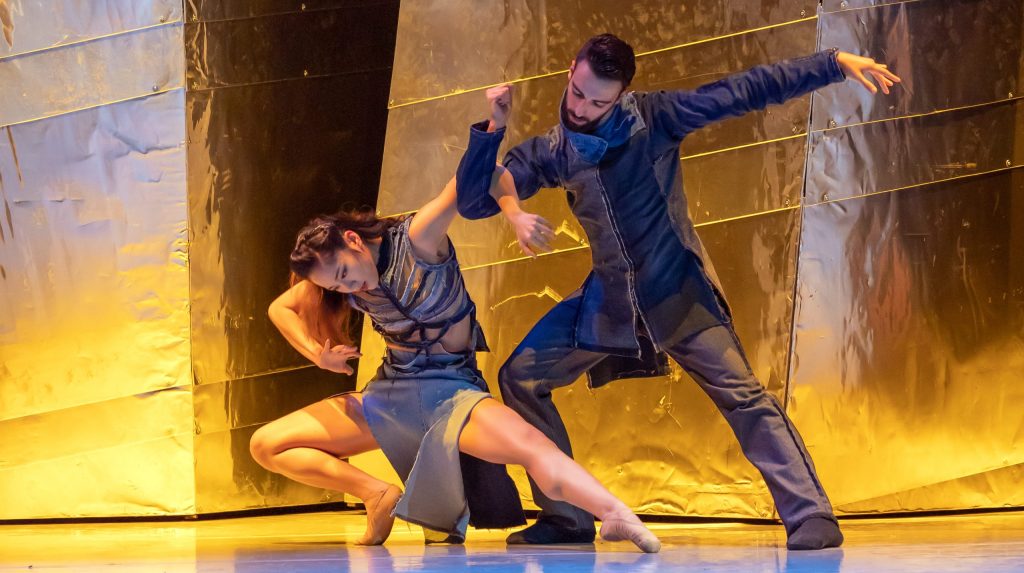Article from Dance Magazine: ‘We’ve got Royal Flair, but live like students’
November 7, 2024
by Astrid van Leeuwen
At Introdans, sustainability isn’t a choice—it’s a necessity. The dance company reuses costumes and sets, and if their old school building, which they’ve occupied since 1985, gets chilly, the staff just bundles up in sweaters. But what about transport and other sustainability challenges? “Be creative, collaborate, and share knowledge and resources,” say Marieke van ’t Hoff, managing director, and Maarten van den Berg, production, technical, and facilities manager.
Before joining Introdans in late 2020, Marieke van ’t Hoff worked for nearly two decades at top architecture firms. “Sustainability was the norm; at my last job with Next Architects, it was as basic as paying your employees a salary.”
Returning to the dance world was quite a shift. “When I started at Introdans, we were consolidating from two troupes to one. There was an intense workload, a financial deficit, the pending retirement of my predecessor Ton Wiggers, and a new arts funding plan to prepare. So, frankly, if sustainability came up, it felt like, ‘We’re barely keeping our heads above water; let’s put that on hold.’”

A Surprising Head Start
To her surprise, Marieke quickly noticed that Introdans was already “super sustainable.” “Roel (Voorintholt, artistic director) would say things like, ‘I’ll just call a company in Switzerland to borrow costumes.’ Roel saw it as resourcefulness—reusing costumes from other companies because there wasn’t a budget to make new ones, but it was also a sustainable choice.”
She also noticed how the staff was accustomed to “making do.” Marieke explains, “Our building doesn’t have air conditioning, and it gets very hot in summer. In winter, it’s chilly because the heating is limited to cut costs. But no one complains; they just wear scarves and sweaters. I realized, with that mindset, we’re already one step ahead.”
‘How Long Will This ‘Dear Old Lady’ Hold Up?’
Originally, Introdans planned to move to the new Stadstheater in Arnhem in 2027, but lack of political support for the budget has put that on hold. Maarten says, “The building’s infrastructure is outdated. Do we spend more on it, knowing accessibility and insulation still won’t be optimal? Or do we hold off, considering it might be demolished in five years?” Marieke adds, “For now, we’re just patching things up. But how much longer can this ‘dear old lady’ hold out? As Roel says, ‘We present ourselves with royal flair, but live like students.’ So we’ve got to be creative. This spring, we launched a crowdfunding campaign, Dancing on the Roof, to install a reflective coating on the studio roof to combat the heat.”
A Bottom-Up Approach
Since 2023, Introdans has had a sustainability task force with members from all departments. Marieke explains, “I wanted the staff to lead this initiative from the ground up, rather than top-down.” Maarten adds, “Many employees wondered, what else can we do to reduce our footprint?”
They’ve started with small steps—ditching disposable cups, addressing slow-heating showers, and replacing halogen lights with LEDs. If a choreographer needs special equipment, they now rent it instead of buying, as they did recently for Stijn Celis’ Swan Lake.
‘Sharing Is Caring’
Maarten also joined the new Sustainable Production Pilot Group, with 17 other cultural organizations in the Netherlands, to tackle common challenges. “Transport is a big hurdle for everyone. We still use diesel trucks and buses, though we’re exploring biodiesel. But rather than each company trying to solve this alone, we can collaborate. Jakop Ahlbom Company, for example, is working with a transport company on an electric solution and plans to share their findings.”
